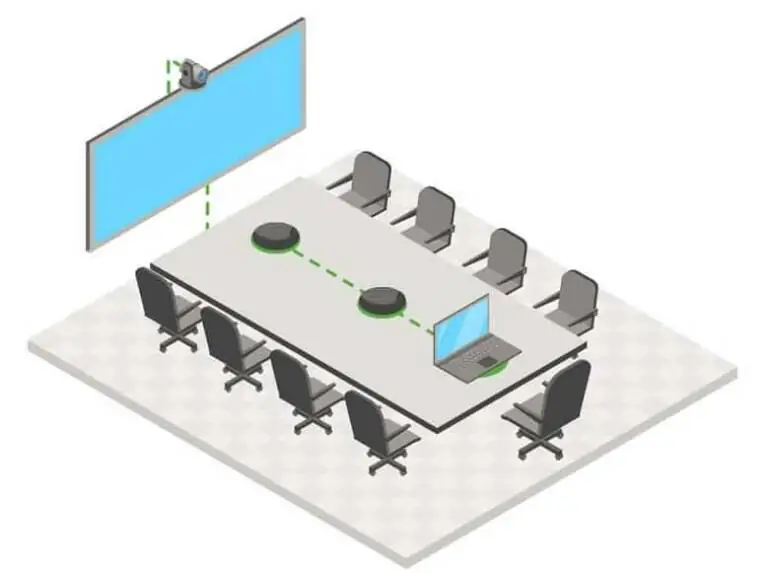Lousy audio in a meeting room can derail your conversation when you are trying to close an important sales call, leaving both sides frustrated.
Sadly, the built-in mic in your laptop is not powerful enough to capture all the voices in a meeting with clarity. This creates a sticky situation in an audio or video conference where everyone is straining to make sense of the conversation (or the pandemonium).
Now, selecting the right microphone to enable seamless and intelligible conference audio can be a daunting task, in contemporary conference spaces. That’s why choosing conference microphones is important, so you can empower your collaborative meeting space and increase business efficiency.
A Quick Introduction to the Types of Microphones
Although there is no one-size-fits-all solution, there are some basics to know, so you can invest in the right conference room microphone for your collaborative space.
Understanding Microphone Directionality
A microphone’s directionality is the angle from which the sound comes. Pick-up patterns of microphones determine the overall range of directions from which the sound is captured.

Selecting the appropriate microphone pick-up pattern depends on the room and the usage. Pick-up patterns are categorised into two types. Directional microphones and Omnidirectional microphones. While directional mics capture the sound from the front, they reject the sound from the rear. It operates on close-up audio captures and is a good fit for a room that has bad acoustics or in situations where you need to amplify a single speaker’s voice.
However, if the space is small there is a requirement for everybody to be heard. There, omnidirectional mics are an ideal choice because they can pick up sound from any direction. Besides that, it can also pick up noise in the background, which may be undesirable.
Evaluating the Meeting Space
It is advisable to measure the space while also being mindful of the reflective surfaces such as tables, raw walls, and windows, as these can cause echoes. Also, don’t miss out on curtains, rugs, and the people sitting in the room, as they would absorb sound.
If we are planning a small huddle room, an omnidirectional ceiling/overhead mic would be an ideal choice as it would capture everyone’s sound. It will also eliminate the cumbersome clutter of cables on a tabletop. But if the meeting room is large, the better choice would be directional microphones mounted on the tabletop. They are located closer to the participants and thereby ensure better audibility even for far-side participants in video calls.
Picking the Right Conference Microphone Design
To cater to different conference room audio scenarios, there are mainly four conference microphone designs.

| Tabletops mics | They are a great pick for a small huddle room with multiple attendees, they can be directional or omnidirectional, depending on the number of people in the meeting. |
| Gooseneck mics | To capture close-up audio and cancel out any background noise, the flexible Gooseneck mics are an ideal choice. They can be placed on a tabletop or podium in a large auditorium where every speaker needs to be heard, with stunning clarity. |
| Wearable mics | For presenters and performers, who need to use their hands to make gestures, or perform while remaining hands-free, wearable mics are the most convenient solution. |
| Handheld mics | These use the directional mic pattern and come handy as a portable solution during a lecture or an interview in a large setting. |
Achieving Clear Audio with Beamforming Technology or Noise Cancellation
For a speaker who needs freedom of movement, how do you ensure the audio clarity remains unobtrusive and uncompromised?

To optimize the speaker’s audio pick even as they are on the move, look for a mic with a spatial filtering or beamforming technology. A beamforming mic consists of eight-element beamforming mic arrays integrated into a single housing. It packs a punch by allowing for three 120-degree zones to equal 360 degrees of coverage. The mic locates the speaker’s location and angle to the mic. By tracking voices even when they’re moving, the beamforming mic array delivers clear audio for everyone on the call so nothing goes unheard during a meeting or presentation.
Alternatively, you could look for a microphone that is equipped with noise-cancelling technology to cut out echoes and background noise that can affect the reception of the speaker’s speech.
Finally, the right microphone is a necessity for productive conferences
It is crucial to remember that in most AV installations, choosing the right microphone can make a big difference between the clear and degraded sound quality. This affects business efficiency in meetings at several levels and therefore should not be overlooked.

So while your built-in laptop mic may suffice for personal use when skyping with family or singing, a high-quality microphone is critical when there is serious business to conduct. In events like town halls or online meetings, this helps capture everybody’s voices and transforms any location into a more productive collaborative space.
FAQ’s
Selecting the correct microphone ensures clarity, minimizes echo, and captures voices evenly across participants. It helps avoid disruptions and maintains professional sound quality during hybrid meetings. The right mic improves communication and creates a better collaboration experience for both in-room and remote users.
Ceiling array and boundary microphones are ideal for modern meeting rooms due to their ability to cover larger spaces and multiple participants. These mics offer clean aesthetics, minimal wiring, and excellent pickup patterns. They maintain uniform sound levels and help deliver consistent audio even in acoustically challenging rooms.
The room size directly impacts mic type, placement, and number. Smaller huddle rooms may need a single table or ceiling mic, while larger boardrooms require multiple zones. Proper planning ensures every voice is captured clearly without distortion, balancing cost efficiency with superior audio coverage for all attendees.
Poor placement, lack of acoustic treatment, and mismatched microphone sensitivity are common issues. These mistakes lead to uneven sound levels, background noise, or echo. Correct calibration and positioning help optimize microphone performance and ensure seamless audio experiences in both physical and virtual meetings.
Consistent sound depends on matching microphones with room acoustics and AV systems. Regular testing, firmware updates, and calibration keep audio clear. Integrating DSPs and echo-cancellation tools further enhances speech clarity, ensuring professional communication across all types of collaboration environments.


